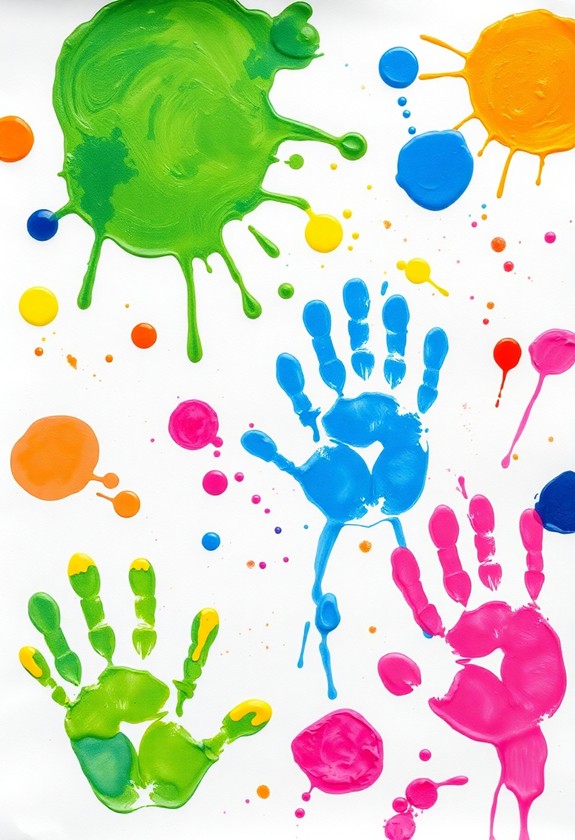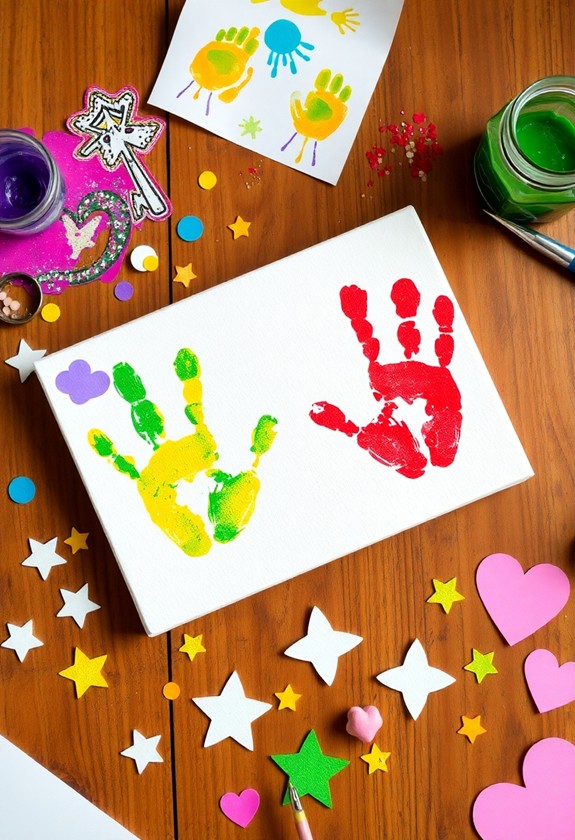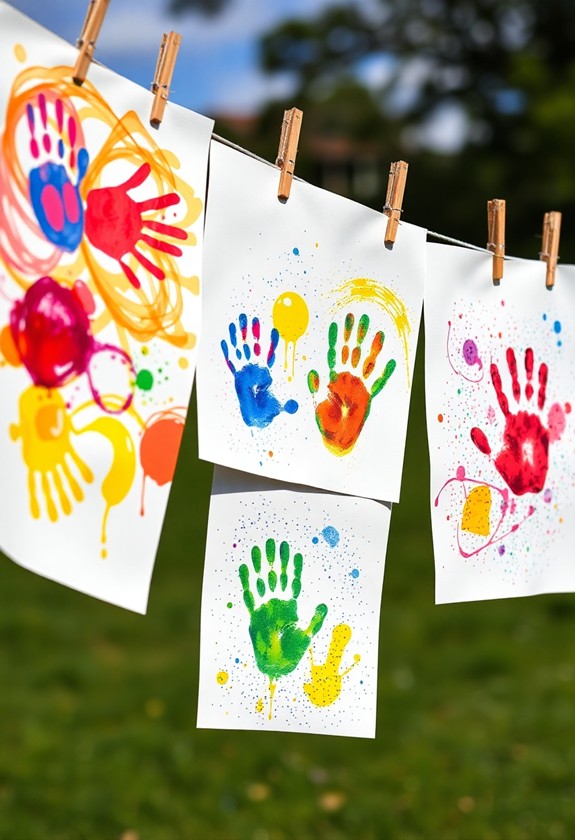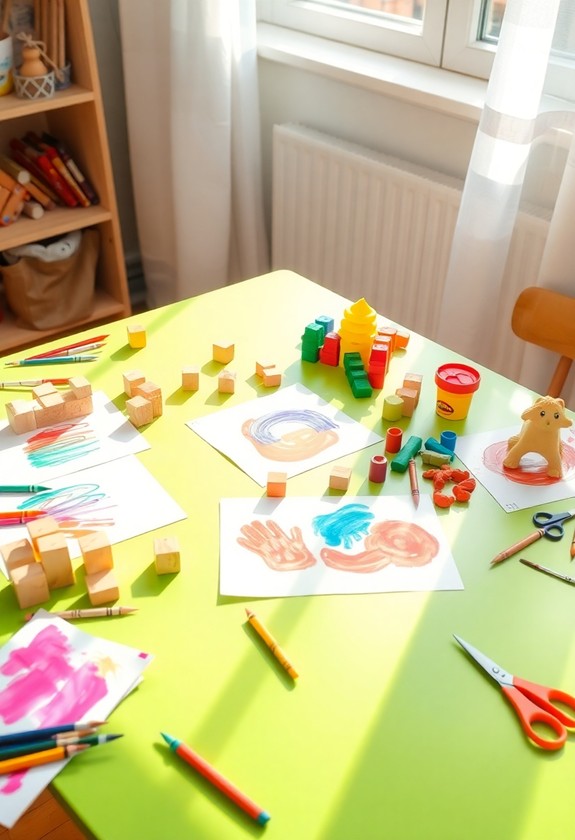Messy play isn't just fun—it's a sensory explosion that'll boost your child's development! Through tactile textures, your little one investigates and learns. Colorful materials enhance visual processing skills. Squelching sounds engage auditory senses, as scented materials tantalize the nose. Movement activities improve proprioception and body awareness. Spinning and swinging activate the vestibular system for better balance. And don't forget fine motor skills—pinching and threading develop essential dexterity! From sticky walks to playdough creations, messy play offers a world of sensory adventures. But wait, there's so much more to uncover about how messy play can transform your child's sensory skills!
Creative Highlights
- Tactile stimulation through various textures enhances sensory development and promotes problem-solving skills.
- Visual processing improves with colorful materials, aiding pattern recognition and spatial awareness.
- Auditory engagement through squelching sounds helps distinguish tones and textures, benefiting sensory integration.
- Olfactory development is enhanced by exploring scented materials, fostering cognitive and creative growth.
- Proprioception and vestibular system activation through movement activities improve body awareness and balance.
Tactile Stimulation Through Textures
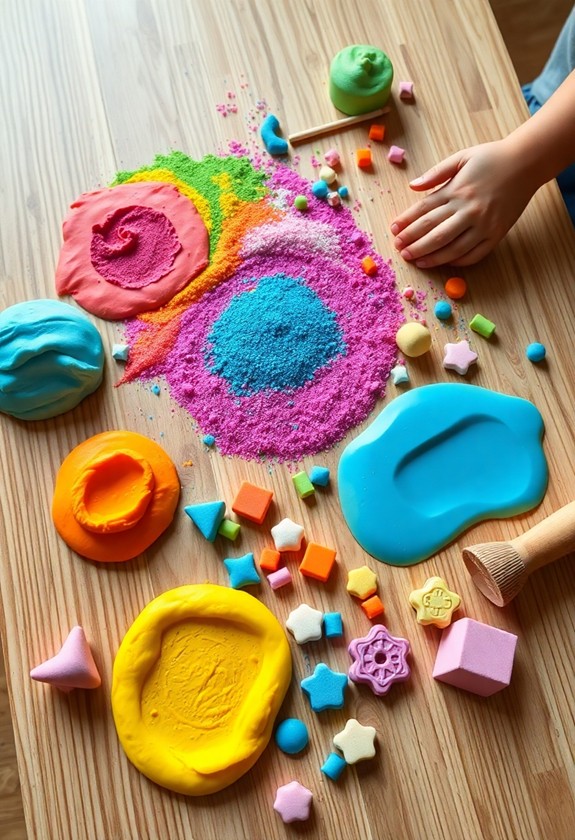
Textures play an important role in a child's sensory development. When you encourage messy play, you're opening up a world of tactile wonders! Let your little ones squish, squeeze, and investigate different materials. It's not just fun—it's brain-boosting! Multi-sensory experiences aid in memory retention and information processing, vital for early childhood development. Regular engagement in tactile activities stimulates brain regions associated with problem-solving and creativity.
Try these texture-tastic activities:
- Gooey slime squishing
- Cloud dough sculpting
- Finger painting with pudding
Your child's fingertips are like tiny investigators, sending significant info to their brain. As they touch rough sandpaper or smooth pebbles, they're building neural pathways. Cool, right?
But wait, there's more! Messy play helps with:
- Fine motor skills
- Language development (describing textures)
- Emotional regulation
Visual Processing With Colors
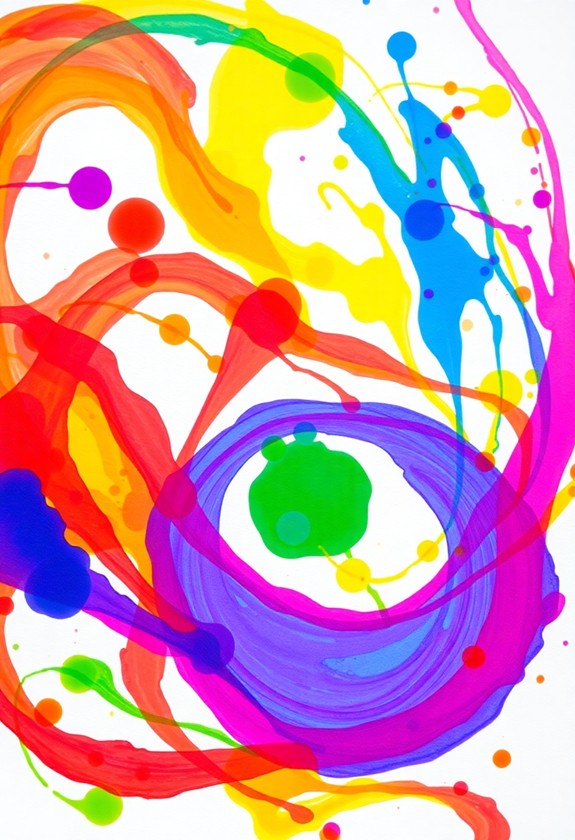
As textures engage the sense of touch, colors ignite the visual aspect of messy play. You'll be amazed at how brilliant hues can transform a child's sensory experience! Mix up some colorful finger paints and watch their eyes light up with wonder. They'll love swirling and blending different shades, creating a rainbow of possibilities! Washable finger paints are ideal for mess-free creativity, allowing easy cleanup and promoting sensory exploration.
Try these exciting color activities:
- Make a color-sorting game with painted ice cubes
- Create a "color hunt" in a tub of rainbow-dyed rice
- Experiment with color-changing slime
But wait, there's more! Visual processing isn't just about recognizing colors. It's about understanding patterns, shapes, and spatial relationships too. Encourage your little one to arrange colorful objects or build with tinted blocks. They'll be boosting their visual skills and having a blast at the same time!
Auditory Engagement in Squelching Sounds
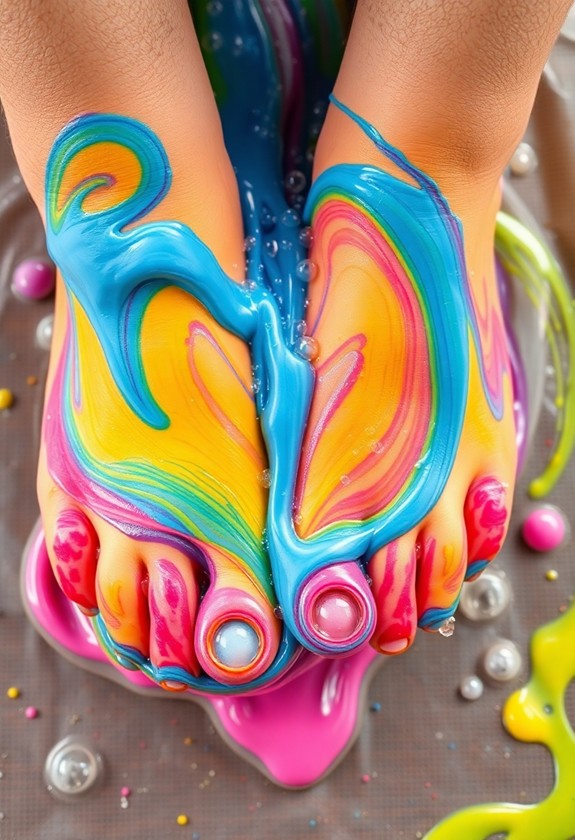
Beyond visual stimulation, messy play engages the auditory senses through squelching sounds. You'll love the squishy, squashy noises that come from play dough, slime, or mud! These sounds are music to your ears and help develop auditory processing skills. Sensory exploration through different textures and sounds can be especially beneficial for children with Sensory Processing Disorders, encouraging sensory integration and reducing anxiety. Listen closely as you:
- Squish play dough between your fingers
- Stomp in muddy puddles
- Pop bubbles in slime
Each sound is unique and exciting! You're not just playing, you're learning to distinguish different tones and textures through sound. It's like an orchestra of squelches! Plus, these activities help you focus on specific sounds, blocking out background noise. So, next time you're getting messy, close your eyes and really tune in to the sounds. You'll be amazed at what you hear!
Olfactory Development via Scented Materials
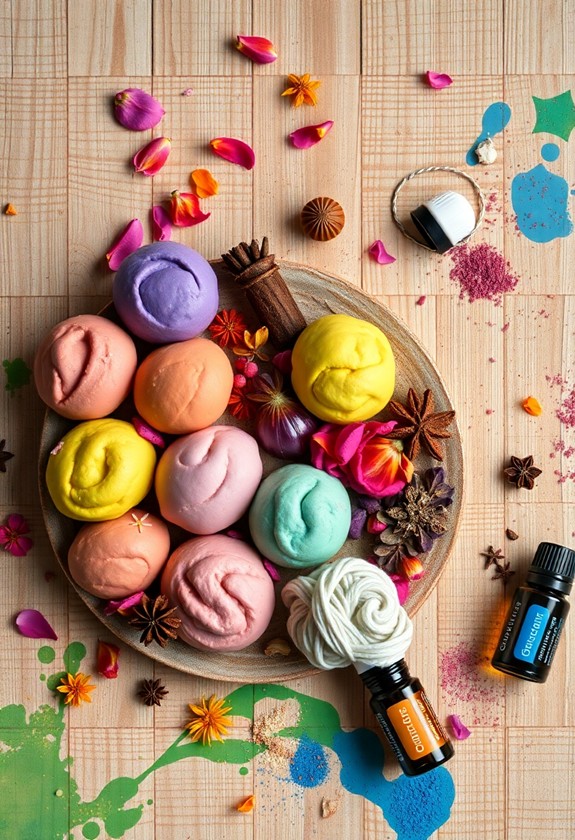
Scented materials in messy play offer a whole new dimension of sensory exploration. Your little one's nose is in for a treat! As they squish, mold, and manipulate scented dough or slime, they're developing their sense of smell in exciting ways. Try these fun ideas:
- Lavender playdough for calm play
- Citrus-scented slime for zesty fun
- Cinnamon-infused sand for spicy digging
But wait, there's more! You can create a "scent station" with different smelly items like coffee grounds, vanilla extract, and peppermint oil. Let your child sniff and guess each scent. It's like a nose-tastic treasure hunt!
Proprioception Enhancement Through Movement
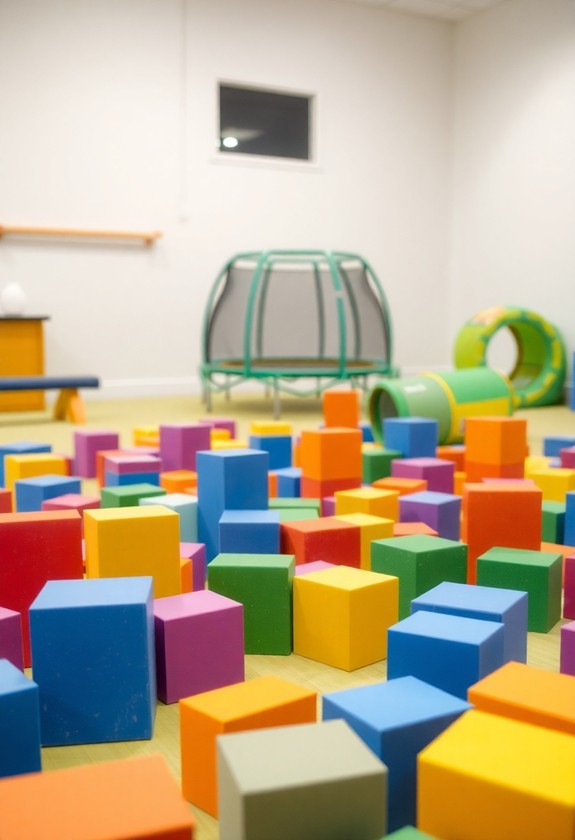
As scents tickle your child's nose, movement engages their entire body. Proprioception, or body awareness, is essential for your little one's development. Let's get messy and boost those skills! Cognitive development through physical activities improves problem-solving abilities and spatial awareness in toddlers.
Try these fun activities:
- Squishy obstacle course: Set up cushions, pillows, and foam blocks for crawling and climbing.
- Slippery slide: Create a soap-and-water slide on a tarp for slipping and sliding.
- Sticky walk: Lay out bubble wrap or contact paper for a tactile adventure.
Watch as your child's coordination improves with each step, jump, and crawl. They'll learn where their body is in space and how to control their movements. It's like they're becoming tiny acrobats!
Vestibular System Activation in Play
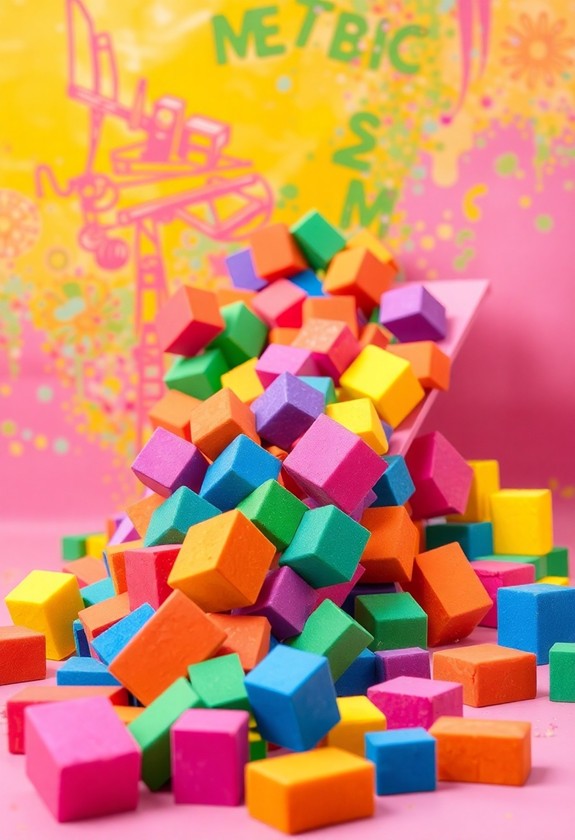
The vestibular system, located in the inner ear, plays a crucial role in a child's balance and spatial orientation. It's like a mini-playground inside your head! When you engage in messy play, you're giving this system a fantastic workout. Spinning, swinging, and rolling are all vestibular superstars!
Here's how you can activate your child's vestibular system through play:
- Twirl and whirl: Encourage spinning games
- Swing time: Hit the playground for some swinging action
- Roll with it: Try somersaults or log rolls on a soft surface
- Upside-down fun: Hang from monkey bars (safely!)
- Seesaw sensation: Balance on a seesaw or wobble board
These activities will have your child's vestibular system doing cartwheels of joy! Remember, messy play isn't just fun – it's a sensory sensation that'll leave your little one feeling balanced and ready to take on the world!
Fine Motor Skills Refinement
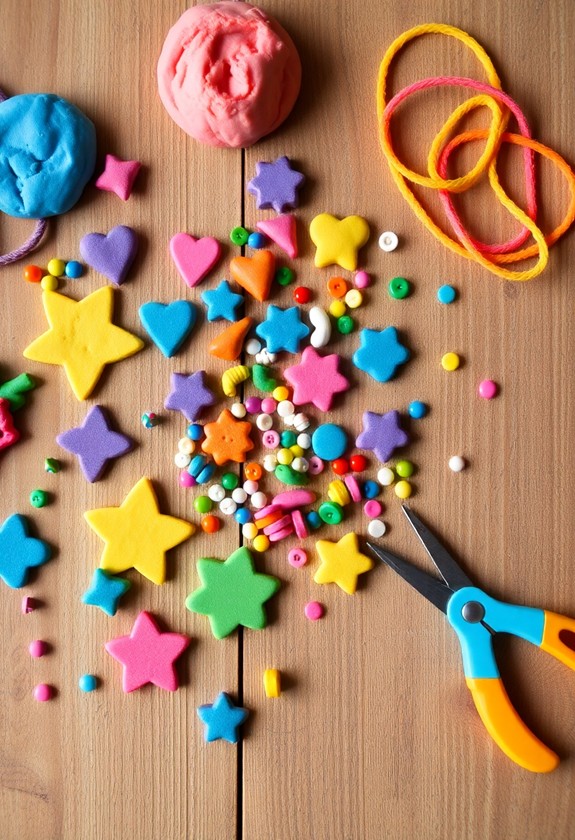
In regard to fine motor skills, messy play offers a wealth of opportunities for refinement. You'll be amazed at how your child's dexterity improves as they squish, squeeze, and mold various materials! Watch as they:
- Pinch and roll playdough into tiny shapes
- Scoop and pour sand with small shovels
- Thread pasta noodles onto string
These activities not only improve hand-eye coordination but also nurture creativity and self-expression in children. Messy play provides a fantastic medium for creative expression and imagination, allowing kids to investigate different textures and materials freely.
But wait, there's more! Messy play isn't just fun, it's a finger fitness fiesta! Your little one will develop stronger hand muscles and better hand-eye coordination. And guess what? These skills are essential for future writing and self-care tasks.
Curious Little Questions
How Old Should Children Be to Start Engaging in Messy Play?
Great news, parents! Your little ones can start messy play as early as 6 months old! It's never too soon to get those tiny hands dirty. As babies grow, they'll love discovering new textures and sensations. By age 1, they're ready for more complex activities. Remember, safety first! Always supervise your child and use age-appropriate materials. Don't worry about the mess – it's all part of the fun! So, grab some paint, play dough, or slime, and let the sensory adventure begin!
Are There Any Safety Concerns Parents Should Be Aware Of?
You'll want to keep safety in mind during messy play. Here are some key things to watch out for:
- Always supervise your little ones closely!
- Avoid small objects that could be choking hazards
- Use non-toxic, edible materials when possible
- Be cautious with hot or sharp items
- Keep allergens in mind for sensitive kiddos
How Can Messy Play Be Incorporated Into Daily Routines?
Ready to make your daily routine a little more colorful? You can easily sprinkle in some messy play fun! Try these ideas:
- Bath time bubbles: Add shaving cream for squishy fun!
- Mealtime magic: Let your little one help mix ingredients
- Outdoor adventures: Dig in the dirt or splash in puddles
- Arts and crafts: Break out the finger paints or playdough
What Are Some Budget-Friendly Messy Play Ideas for Home Use?
You'll love these budget-friendly messy play ideas for home! Get ready to have a blast:
- Whip up some gooey slime with glue and borax
- Create a sensory bin with rice, beans, or pasta
- Paint with pudding or shaving cream on a tray
- Make "mud" pies in the backyard with dirt and water
- Squish and mold homemade playdough
These activities are cheap, easy, and oh-so-fun! Plus, they'll keep your little ones entertained for hours. Let's get messy and creative!
Can Messy Play Benefit Children With Sensory Processing Disorders?
Messy play can be a game-changer for kids with sensory processing disorders. It's like a sensory playground for their senses! You'll see them light up as they squish, splash, and investigate different textures. It's not just fun, it's therapeutic too! Messy play helps:
- Improve sensory integration
- Boost tactile awareness
- Reduce sensory sensitivities
Plus, it's a stress-buster! So, get ready to make a delightful mess and watch your child's confidence soar. Remember, messy today, skilled tomorrow!

